7. EXPANSION ... AND DIVISION

TEXAS INDEPENDENCE
CONTENTS
 Americans and Europeans to Texas Americans and Europeans to Texas
 The move to Texas independence The move to Texas independence
 The Battle of the Alamo ... and the The Battle of the Alamo ... and the
massacre at Goliad
 Texian victory at San Jacinto (April 1836) Texian victory at San Jacinto (April 1836)
 The debate over Texas joining the Union The debate over Texas joining the Union
(1837-1845)
The textual material on this webpage is drawn directly from my work
America – The Covenant Nation © 2021, Volume One, pages 249-252.
|
A Timeline of Major Events during this period
| 1820s |
Americans pour into northern Mexico (the Coahuila y Tejas Province)
1820s At the invitation of the Mexican government (needing Europeans to counter fierce Indian
resistance) Stephen Austin (and others) flock to Tejas ... mostly
land-hungry Southerners
|
| 1830s |
The "Texians" move to independence
1830 Overwhelmed by the American buildup in Tejas (Texas), Mexico now blocks further immigration
1832 Sensing rising Mexican resistance, "Texians" increasingly look to the idea of independence
1835 Mexicans send soldiers north to break this spirit of independence ... but only deepen it
1836 Texans meet and declare Texan independence (Mar)
The
Mexicans respond immediately in sending a large force North ... to
overrun (and massacre)
Texans gathered at the Alamo; Texans captured elsewhere are massacred
at Goliad (also Mar)
Texans defeat a huge Mexican army and capture Mexican general/dictator
Santa Anna at the battle of San Jacinto (April); effectively, Texas is now independent
1837 Now begins the debate as to what Texas is to do ... possibly even join the US – something fiercely resisted by anti-slavery Northern politicians
The
American economic depression now underway seems to be a higher national
priority
|
AMERICANS AND EUROPEANS TO TEXAS |
|
Texas
(Tejas) was originally a sparsely settled northern portion of New
Spain. In 1821 there was a general revolt of the Hispanic population
(The Mexican War of Independence) against the authorities back in
Spain, which resulted eventually in the creation of the Republic of
Mexico two years later. The huge northern region was so sparsely
settled that two huge regions were formed into the single state of
Coahuila y Tejas.
The Comanche Indians were a constant
problem for the Hispanic settlers and the decision was made in 1824 to
encourage European and Americans to settle in the area.
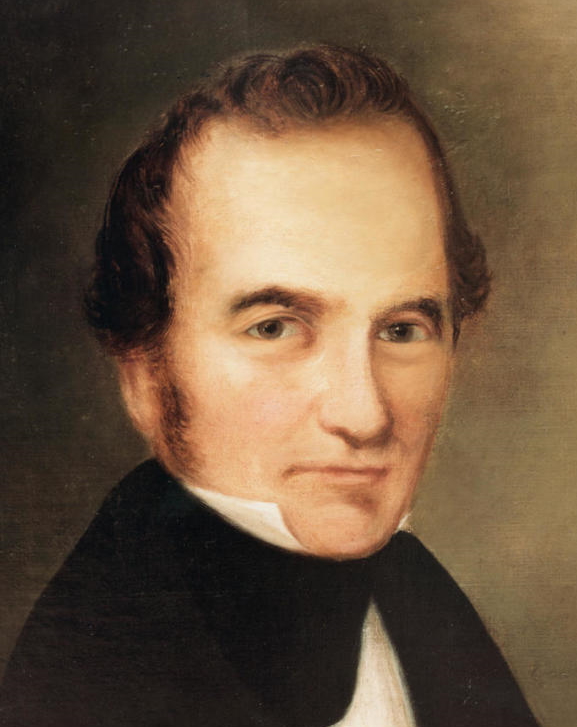 This had
already been happening on a small scale – as in the case of the empresario, Stephen F. Austin,
bringing some 300 Americans to settle along the Brazos River in 1822.
Then with this decision a large number of others, mostly Americans,
were settled in Texas under a number of similar empresarios. Finally
the influx of Americans was so overwhelming in numbers1 that in 1830 Mexican President Anastasio Bustamante closed the borders to further immigration.
This had
already been happening on a small scale – as in the case of the empresario, Stephen F. Austin,
bringing some 300 Americans to settle along the Brazos River in 1822.
Then with this decision a large number of others, mostly Americans,
were settled in Texas under a number of similar empresarios. Finally
the influx of Americans was so overwhelming in numbers1 that in 1830 Mexican President Anastasio Bustamante closed the borders to further immigration.
But the American immigrants, sensing the
Mexican effort to isolate them, fought back – at the same time that a
revolt against the Mexican president was taking place in the Mexican
capital. Taking advantage of the political chaos and supporting the
party of Mexican Federalists fighting the Mexican Centralists, Texans
gathered at the Convention of 1832 to discuss the option of independent
statehood. The spirit of independence was thus birthed in Texas.
1At
the beginning of the migration in 1825 there were only about 3,500
settlers in Texas, mostly Hispanic. Less than ten years later that
figure was over ten times that size, about 80 percent of them
Americans, with a substantial number of slaves among them.
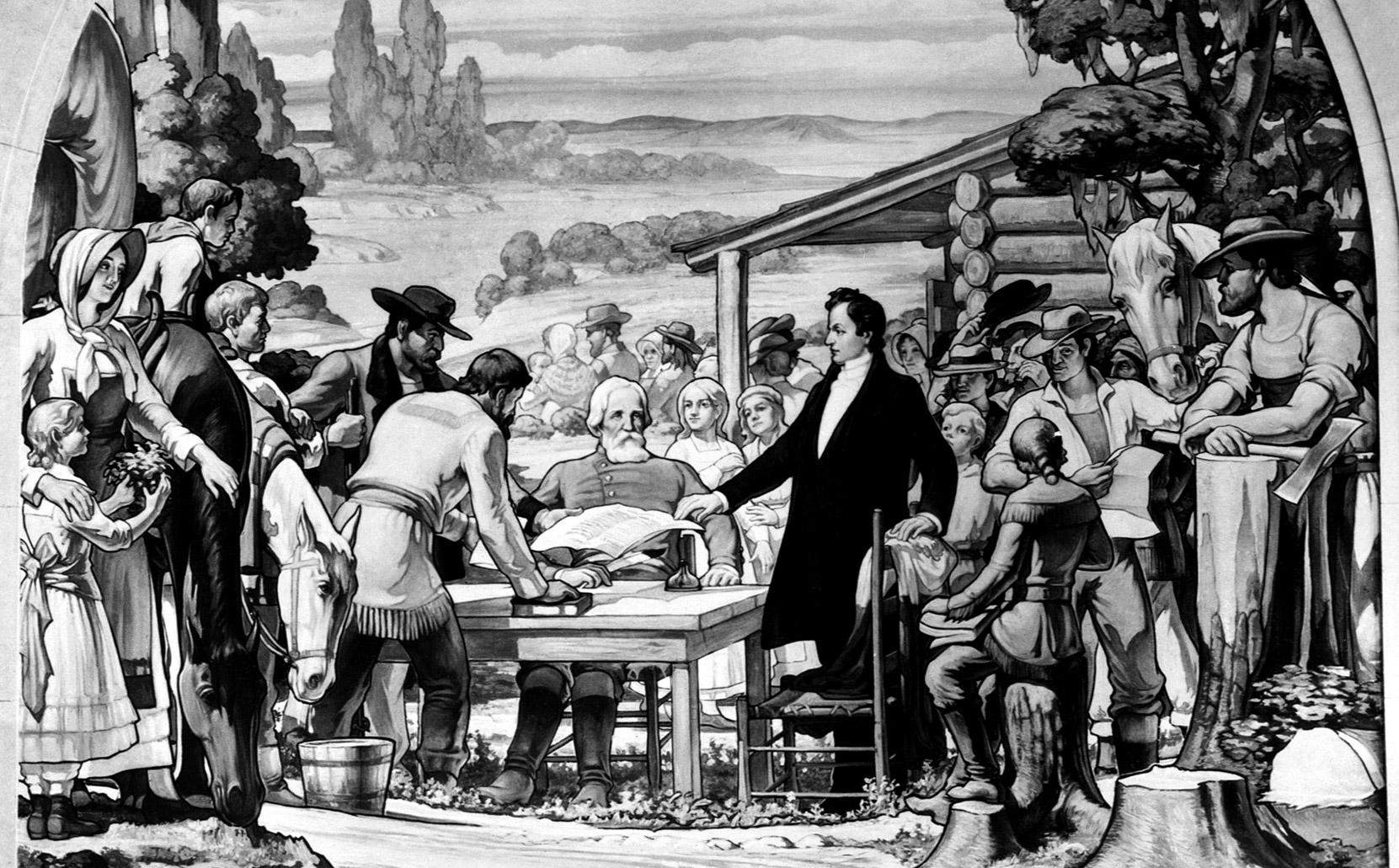
"Empresario" Austin registering some of the 300 new settlers brought to Texas (1822)
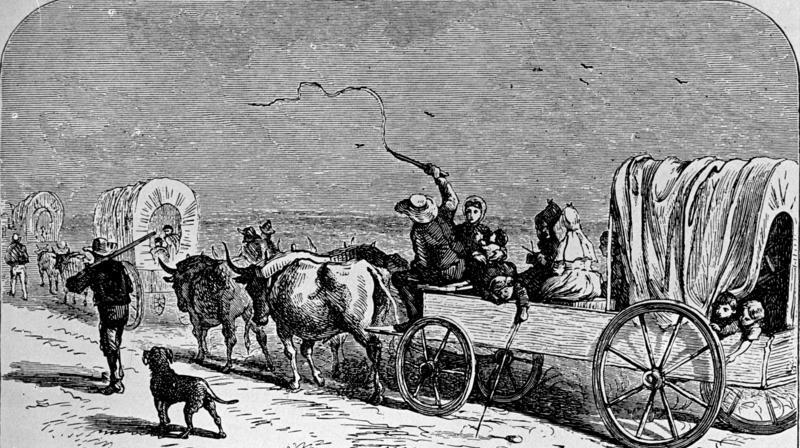
German immigrants making their way to Texas
THE
MOVE TO TEXAS INDEPENDENCE |
|
The Battle of Gonzales and the Consultation (1835)
When in 1835 a small Mexican military contingent
was sent north to crush this spirit, a similarly small group of Texans
fought the Mexicans to a standoff at the Battle of Gonzales, merely
strengthening the desire of the Texans to achieve independence. They
gathered that same year (The Consultation), declaring their reasons for
seeking independence and setting up a provisional government and
General Council. They also established a Texas army under Sam Houston.
But political controversy immediately
plagued the new government, which collapsed in early 1836. However,
another gathering that spring produced quickly a formal Declaration of
Independence (March 2nd, 1836) and the announcement of the creation of
the Republic of Texas.
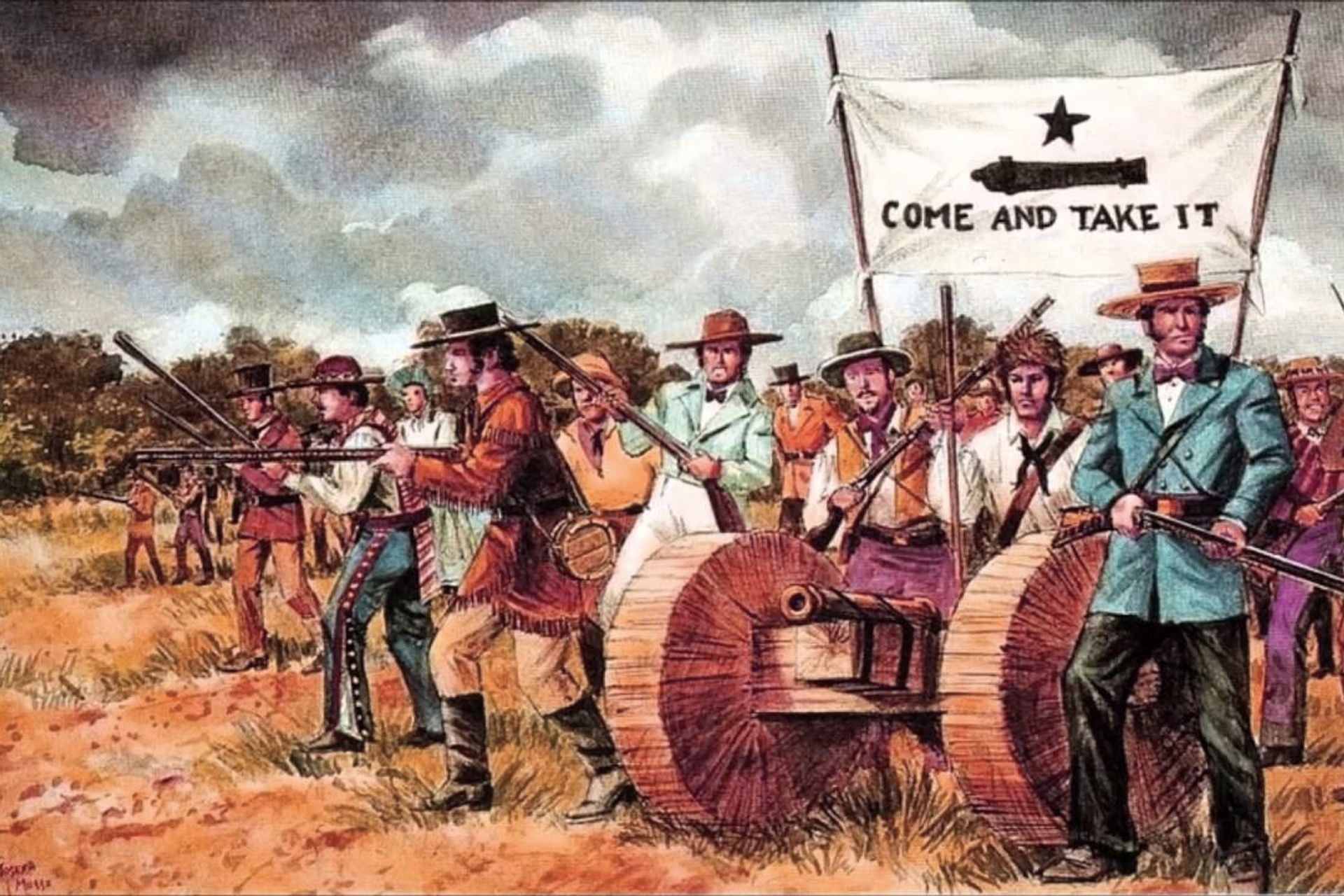
The Battle of Gonzales – October 2, 1835
A small group of Texans challenging a group of about 100 Mexican soldiers
sent north to seize a canon from the Texans
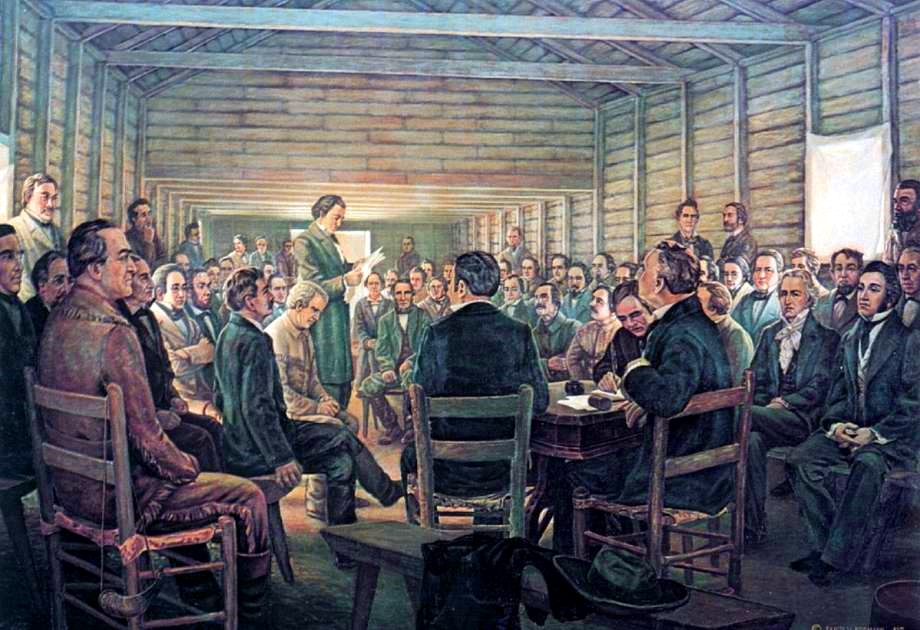
The Battle of Gonzales drove the Texans to gather for a "Consultation" (mid-October 1835) ... where they decided formally to take the path of independence ... and to appoint Sam Houston to head their army
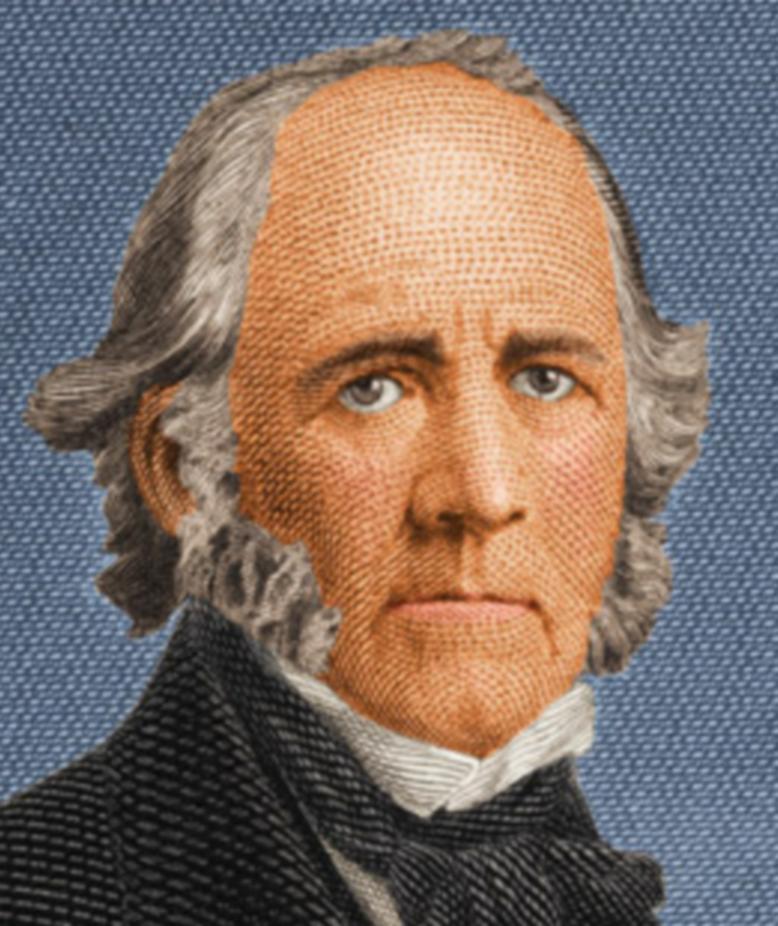
Sam Houston, former governor of Tennessee, takes command of the Texas militia(the "Texians") and the independence movement itself (1835) ...
becoming also the Republic's first president (1836)
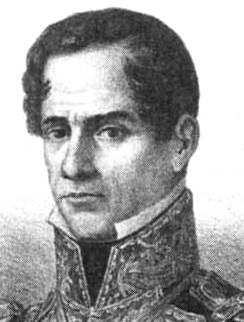
Opposing him was the military strongman (caudillo) and Mexican President Antonio López de Santa Anna
THE BATTLE OF THE ALAMO ... AND THE MASSACRE AT GOLIAD (March
1836) |
|
At the same time, the new Mexican president (and military caudillo
or strongman), Antonio López de Santa Anna, had already headed north
with the intention of crushing this Texas rebellion. Santa Anna's army2
surrounded the Alamo Mission near San Antonio and finally, after a
siege of almost two weeks, overwhelmed the approximately 185 defenders
(March 6), killing all of them to the last man. But in fact it was
quite an expensive victory, costing Santa Anna the loss of 400 to 6003 of his army in dead and wounded.
At about the same time another large
Mexican Army began to move north from Matamoros, overwhelming small
Texas units as they went. In mid-March a larger Texas unit confronted
the Mexicans in three days of fighting. But the Texans ran out of
ammunition and were surrounded and forced to surrender as they
attempted a retreat. The Texans were marched back to Fort Defiance in
Goliad. Then, under the orders of Santa Anna, the Mexican troops
proceeded to massacre over 300 of these prisoners (March 27). But
rather than breaking the spirit of the Texans, the event merely steeled
their determination to secure Texas independence at all costs.
2The
exact size of the Mexican army and the portion actually involved in the
final assault on the Alamo are not known, though figures vary from
1,800 all the way up to 6,000.
3Some estimates are much higher ... but are hard to confirm because of the political implications of those numbers at the time.
The Battle of the Alamo (February 23-March 6, 1836)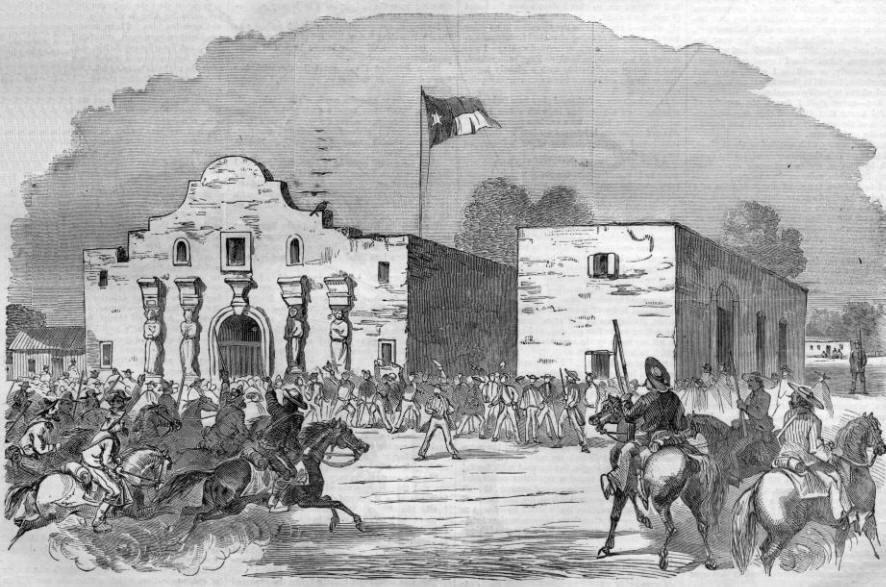
Some 3000+ Mexican troops surround the Alamo mission in which an unknown number (from 180 to 250) of Texians were defending.

The final Mexican assault (March 6, 1836)
(basically all the Texian defenders at the Alamo were killed)
The massacre at Goliad prison (March 26, 1836)

The massacre by Mexican troops of over 400 Texian prisoners at Goliad
TEXIAN VICTORY AT SAN JACINTO (April
25, 1836) |
|
The next month Sam Houston and his Texas army
joined battle with Santa Anna at San Jacinto. A Texan surprise attack
on a wearied Mexican army and a twenty-minute battle turned out to be a
disaster for the Mexicans. They tried to flee but were simply hunted
down and killed on the spot, to the cries of "Remember the Alamo" and
"Remember Goliad!" (some 600+ Mexican soldiers were killed this way).
And Santa Anna was captured, disguised as a servant in an attempt to
escape. Amazingly, only eleven Texans died in the battle.
At this point (and after three weeks of captivity) in order to secure
his own release Santa Anna had to agree to recognize Texas's
independence. But Santa Anna would immediately repudiate the agreement
once he was safely out of Texas.
|
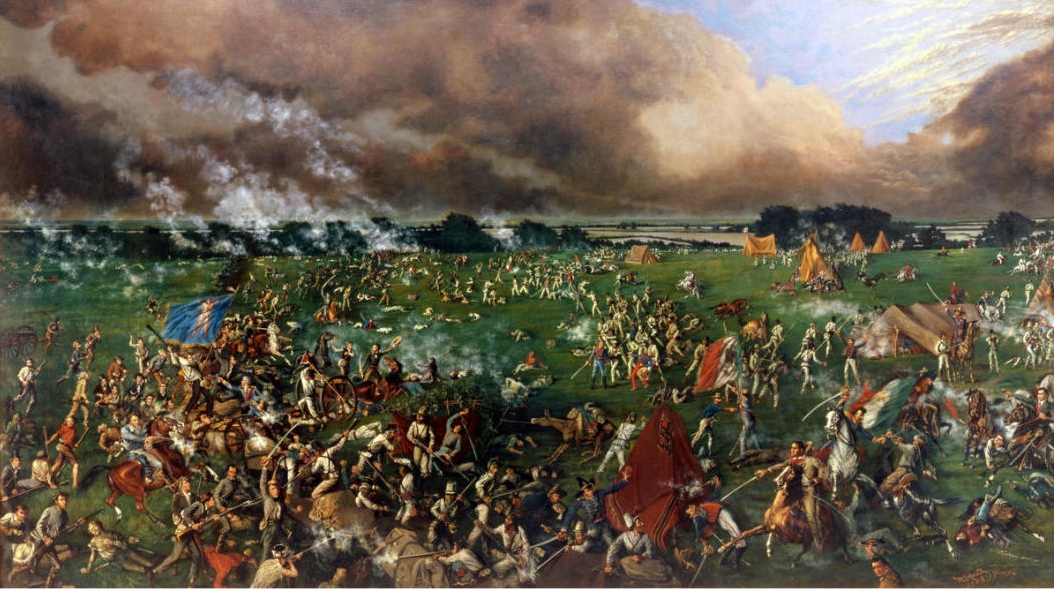
To the cries of "Remember the Alamo" and "Remember Goliad," Texian troops attack Santa Anna's Mexican troops taking their afternoon siestas. The terrified Mexican troops fled ... ending the battle with a Texian victory in only 18 minutes of action!

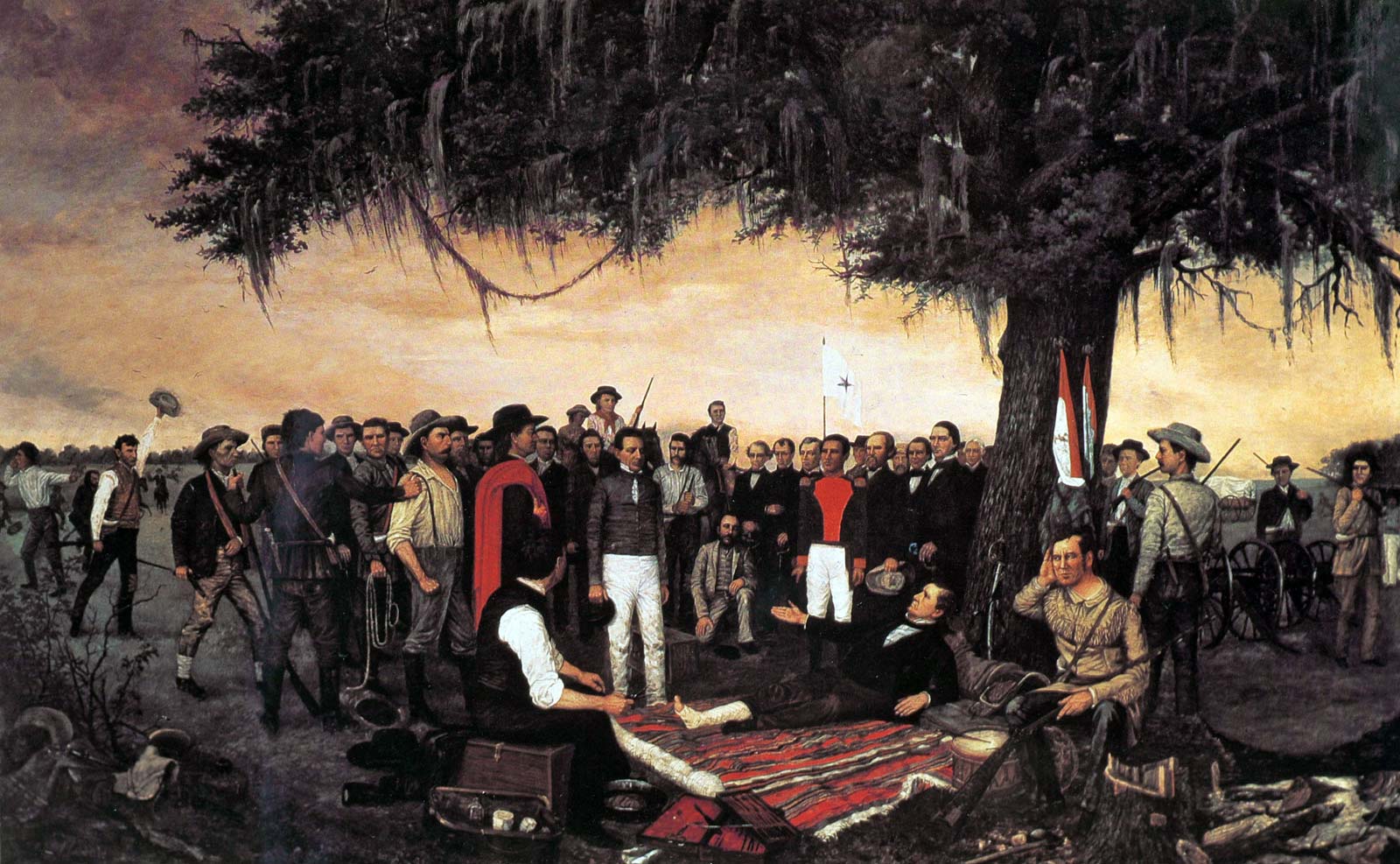
The next day a captured Santa Anna (who tried to flee dressed as a private soldier) is brought before Sam Houston in abject surrender
THE DEBATE OVER TEXAS JOINING THE
UNION (1837-1845) |
|
Almost immediately (1837) a split occurred within
the leadership of the new Texas Republic between those wishing to
retain and expand Texas as an independent republic (possibly extending
its borders all the way to the Pacific Ocean) and those who wanted to
see Texas annexed as a new state joining the U.S. The debate was
finally decided in favor of the annexation group when Mexico sent
troops back up into Texas and had to be fought off with much
difficulty. This seemed to establish in Texan minds the importance of
being closely connected to the greater power of the U.S.
But Texas allowed slavery, stirring
debate within the United States itself as to whether or not Texas ought
to be admitted as a new (slave) state. President Van Buren did not want
the slave issue to work its political damage at a time when he was
struggling with the economic Panic of 1837 and so he tried to hold off
the issue of Texas admission throughout his entire four-year tenure as
president. Also he did not want to find the country at war with Mexico
– which had never accepted the idea of the independence of Texas. But
he faced a lot of adversity from Southerners, especially from Calhoun
who was making it an issue of the South's willingness to stay in the
Union if Texas were not admitted. But opposing Calhoun was John Quincy
Adams, who had returned to Washington after his presidency to become a
very powerful voice in the House of Representatives, and who spoke for
three weeks in opposition to the admission of Texas.
|
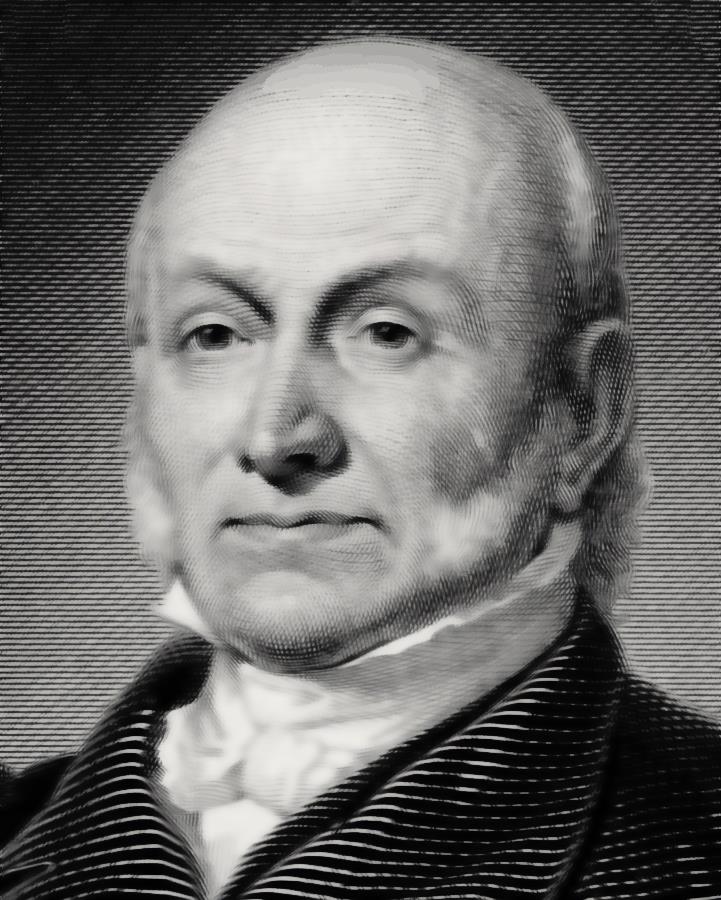
John Quincy Adams (opposed)
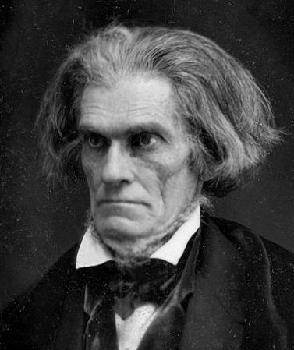
John C. Calhoun (insistent on entry)
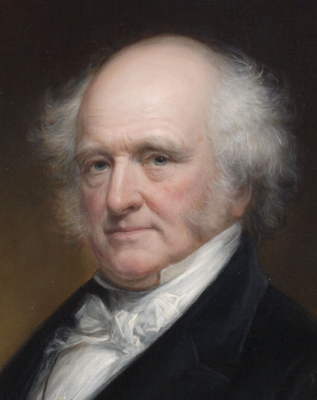
President Van Buren (attempting to avoid the decision)

Go on to the next section: "Tippecanoe and Tyler Too"
 Miles
H. Hodges Miles
H. Hodges
| | | | |

 Americans and Europeans to Texas
Americans and Europeans to Texas  The move to Texas independence
The move to Texas independence The Battle of the Alamo ... and the
The Battle of the Alamo ... and the Texian victory at San Jacinto (April 1836)
Texian victory at San Jacinto (April 1836)  The debate over Texas joining the Union
The debate over Texas joining the Union
















